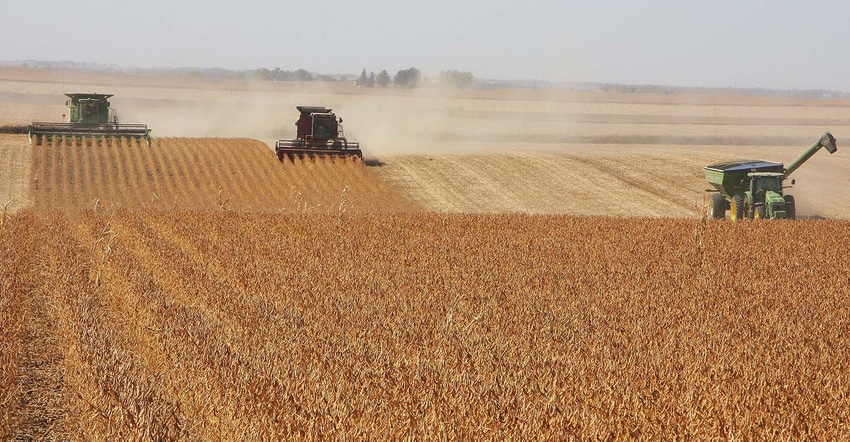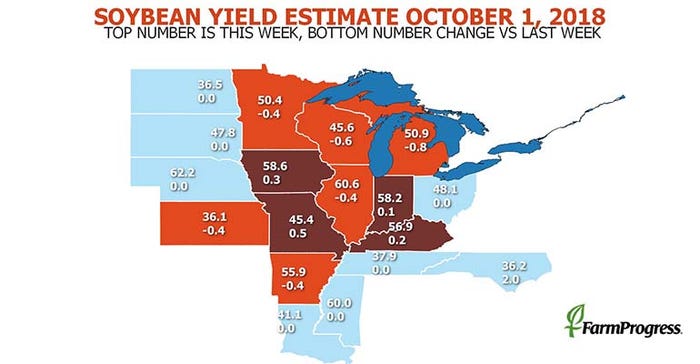USDA crop progress: Corn harvest reaches 26%, soybeans at 23%
Harvest rolls forward, with winter wheat planting progress also moving along.

October is a time for harvest – and for planting, depending on what crop you’re talking about. Corn and soybean harvest have passed or neared the quarter-complete milestone, while winter wheat planting progress nears the halfway mark, according to the latest USDA Crop Progress report.
“With the growing season winding down only minor changes were seen overall on today’s ratings,” according to Farm Futures senior grain market analyst Bryce Knorr. “While nationwide ratings were steady for both corn and soybeans, our state-adjusted yield forecasts showed a little fluctuation.”
Corn harvest progress for the week ending September 30 has reached 26% complete, up from 16% the prior week and moderately ahead of 2017’s pace of 16% and the five-year average of 17%. Seven of the top 18 production states are near or past the halfway mark, including Illinois (48%), Kansas (47%), Kentucky (60%), Missouri (65%), North Carolina (83%), Tennessee (64%) and Texas (70%). The bottom three states have yet to make double digit progress, meantime, including Minnesota (8%), North Dakota (6%) and Pennsylvania (9%).
Most of this year’s corn crop is mature according to USDA, with 86% having reached that stage last week – up from 72% the prior week and ahead of 2017’s pace of 66% and the five-year average of 71%.
USDA left corn condition unchanged from the week prior, with 69% of the crop in good-to-excellent condition. Another 19% of this year’s crop is rated fair, with the remaining 12% rated poor or very poor. Nebraska still leads the top 18 production states with the highest quality crop, with 83% of its crop rated good-to-excellent.
“Corn gained a tenth of a bushel per acre after good gains in Indiana and Illinois offset declines in Michigan, Missouri and Pennsylvania,” Knorr says. “That leaves yield estimates at 177 bushels per acre to 178.5 bpa for corn.”
For the soybean crop, 83% is now dropping leaves, up from 71% the prior week and ahead of 2017’s pace of 78% and the five-year average of 75%. And harvest took a moderate step forward, reaching 26%. That progress moved ahead of the prior week’s tally of 14% and remains a bit ahead of 2017’s pace and the five-year average, both at 20%.
USDA made no changes to soybean crop quality, leaving it at 68% in good-to-excellent condition. Another 22% of the crop is rated fair, with the remaining 10% rated poor or very poor.
“The state-by-state soybean yield was slightly lower, weighed down by losses in Arkansas, Michigan and Minnesota,” Knorr says. “Yield projections based on ratings remain behind those forecast by USDA September 12 at 50.8 bpa to 51.7 bpa.”
The 2018/19 winter wheat planting season moves ahead, with 43% of the crop now in the ground. That total is up from the prior week’s tally of 28% and remains somewhat ahead of 2017’s pace of 34% and the five-year average of 40%.
Other crop progress of note:
Sorghum harvest progress reached 34% (up from 30% the prior week).
Sugarbeet harvest progress reached 22% (up from 16% the prior week).
Peanut harvest progress reached 21% (up from 10% the prior week).
Cotton harvest progress reached 19% (up from 16% the prior week).
Rice harvest progress reached 70% (up from 65% the prior week).

About the Author(s)
You May Also Like





